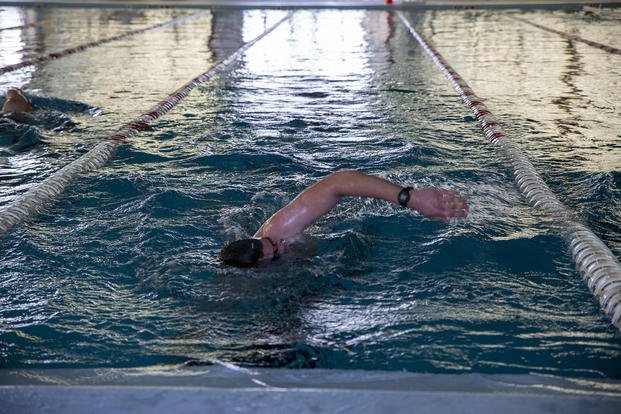When candidates are training for the Navy physical screening test (PST) for SEAL, EOD, diver, SWCC and air rescue jobs, they typically find improvements in running and swimming the toughest to achieve, especially when compared with calisthenics events.
My advice is to focus on your goal paces in running and swimming. Start training with direct purpose, versus just running and swimming with no set goal for each lap of a pool or track.
Here is an email question from a candidate who needs help with the cardio events.
Stew, I need some cardio advice on both running and swimming. I am OK on running, above average on the push-ups, pull-ups and sit-ups of the PST, but I still need to get faster with running and swimming to be competitive. Any advice on improving my cardio and still maintaining the PT scores? I am willing to focus on this for the next 2-3 months, if needed. Thanks, Baldy
Baldy, your situation is not uncommon. Most people have the hardest time with these events, so you are not alone.
Here are the things to consider:
Swimming
Swimming improvement will at first focus more on technique, then more on conditioning. The combat side stroke (CSS) is an option, though you also can use the elementary sidestroke or breaststroke kick if you prefer. In my opinion, the CSS is better for non-swimming athletes as the other strokes tend to be slower, which can make them more difficult. However, you will find more swim instructors who know the breaststroke and side-stroke kick than ones who know the CSS.
Try to get someone to film you swimming the CSS for 50 meters, walking alongside you on the pool deck. Send that footage to stew@stewsmith.com, and I can critique it for you. In fact, I have made a TikTok page with more than 100 CSS critiques in the last few months. Check it out and see whether that type of voice-over coaching helps you figure out what you are doing wrong.
For swimming, you should master a specific pace for each 50-yard lap and then get in shape to maintain it for 500 yards. If you can swim 50 yards in 50 seconds, you are on pace to swim 500 yards in 500 seconds, which is an 8:20 time. That is a good above-average swim and an easy way to see whether you are on pace for each lap. Work on your technique if 50 yards in 50 seconds is not yet possible. This is not a sprint, though; this is an easy-paced swim with as few strokes as possible (typically 5-7 strokes per length of 25 yards).
If you have the pace down to 50 yards in 50 seconds, but simply cannot maintain it, then you have a conditioning issue. For this, I recommend doing the 50-50 workout 4-5 times a week for a month and watch your conditioning in the water dramatically improve. I have seen people using the technique go from 10 minutes to eight minutes in as little as 3-4 weeks.
Running
Running is similar. How you run matters if you want to do it pain free and efficiently. Have someone who is a better runner or a running coach watch you run so they can offer pointers.
See some running technique articles on the military.com fitness pages:
One way to get in better running shape is to practice your goal pace (within a minute of your mile pace). For instance, if you run a seven-minute mile (or 10:30 1.5-mile run) and you want to do a six-minute mile pace (9:00 1.5-mile run), try this type of Goal Pace Running workout.
All your runs should be at that six- to seven-minute mile pace. There's no need to run slower. If you want to build your cardio base, you can do it with swimming workouts and other non-impact cardio events like biking or rowing.
This technique prevents the unnecessary higher volume that will cause overuse injuries like knee tendinitis, foot pain or shin splints. If you are relatively new to running, the better option is to treat your cardio training like a triathlete would. Two-thirds of your cardio training is non-impact based, and running is a third of your cardio training time per week. Run with a purpose.
Train with a purpose, too. Consider a cycle focused primarily on crushing the PST. That means doing calisthenics upper body every other day with workouts like pyramids, supersets and max-rep sets. Do lower-body PT (squats and lunges), mixed with running, on the days between upper-body days two times a week. Your running and swimming need to occur near daily 4-5 times a week. Build up to six days per week. This cycle may take 12-16 weeks to progress to the levels you need on the PST, so be patient and get to work.
Stew Smith is a former Navy SEAL and fitness author certified as a Strength and Conditioning Specialist (CSCS) with the National Strength and Conditioning Association. Visit his Fitness eBook store if you're looking to start a workout program to create a healthy lifestyle. Send your fitness questions to stew@stewsmith.com.
Want to Learn More About Military Life?
Whether you're thinking of joining the military, looking for fitness and basic training tips, or keeping up with military life and benefits, Military.com has you covered. Subscribe to Military.com to have military news, updates and resources delivered directly to your inbox.



















